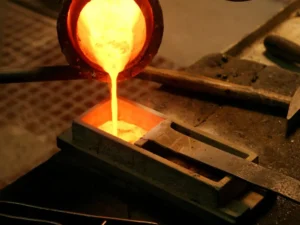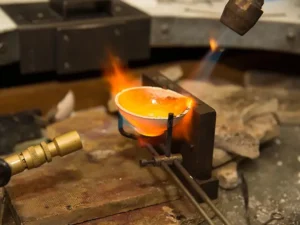Introduction
Do you work in the metal industry? Steel cutting, welding, or stamping have to go through various phases of metal processing. Therefore, understanding the melting point of steel demonstrates how you can exactly perform your work. Or sometimes, what heating temperature or tools do you need to dress up your work? It is not just the melt temp of steel that is necessary. Instead, various metals such as aluminum, iron, copper, or brass are crucial in the metal industry. We have compiled a complete list of melting points of metals.
Also Read: Sheet Metal Gauge Chart
What is the melting point?

Metal melting point is a specific threshold temperature at which your metals transform into liquid. Whenever you cross the upper limit of temperatures, the metal starts converting into liquid.
Guess why it even happens? The temperature has enough energy to break the powerful bonds between the solid molecules and convert them into liquids.
Whatever solid material you observe has a specific range of melting points. Some would have higher melting points, while others have low melting points.
Why is it necessary to know the melting points?

Knowing the melting points is crucial for several reasons. These include:
Alloys
Alloy manufacturing is an essential job in the industry. Whenever you need to make some alloys, melting points come on top. You must know what metal is suitable and what tools you need.
Metal Casting
In Metal casting, you have two different types of metal. One is the metal itself, and the other is the casting equipment. The casting equipment must have a high melting. Otherwise, it will melt and will be of no use. At such a point, the melting point is a game changer.
Metal Applications
Some industries require the use of high melting point metals. For example, aircraft or heavy engines must rely on high melting point metals. Even the electrical industry uses tungsten metal, which has the highest melting points.
What factors change the metal melting point?
Metal melting point relies on a variety of factors. We have listed some key factors that influence the melting points.
Pressure
Pressure can turn the tides either way—for instance, a high-pressure application increases the melting temperature. If you wonder what happens with low pressure, it will create a gap between the molecules and lead to easy breakage whenever you apply the heat.
Therefore, pressure can change the game of meta melting point.
Bonds
What types of bonds do your molecules have? A stronger bond between the metal alloys is also crucial. It shows how easy it is to break the link between the molecules.
An ionic bond is relatively more robust than a covalent bond. Therefore, all the metal alloys with ionic bonds have high melting points.
Impurity
A pure metal has a high melting point. On the other hand, an impure melt temperature of steel would be lower.
Whenever experts have to reduce the melting temp of steel, they add impurities and get their job done!
Why do some metals have a higher melting point than others?
It depends on the bonds between the metals and the gaps between the molecules. The tight lattice structure increases the melt point of stainless steel.
Lowest melting point
Do you know the metal with the lowest melting point? It is none other than mercury. Its melting temperature is -39°C. Therefore, it is liquid at room temperature.
Highest melting point
The highest melting point is of the tungsten metal. It melts when the temperature reaches 3,399°C.
Melting points of 10 Metals you should know!

Many metals are not available at the store. Some popular household metals are copper in wires and plumbing, iron, or stainless steel.
However, we have listed ten commonly used metals in the industry and added their melting points. Check them out!
1. Melt point of steel
Who doesn’t know the uses of steel? From kitchen utensils to the construction industry, steel has achieved milestones. Moreover, there are many alloys of steel.
Its melting point ranges from 1371°C to 1540°C. But it doesn’t end here because steel is available in various alloy forms. One of the most popular alloys is stainless steel, famous for its strength. Therefore, know about its multiple alloys.
2. Aluminum metal melting point
Aluminum is one of the most fascinating metals used widely in the industry. From aluminum window frames to the aerospace industry, it has gained popularity all around.
It is famous for its low melting point compared to other metals. Aluminum melting temperature reaches whenever you cross 660 degrees Celsius. It melts at this temperature.
3. Copper metal melting point
Copper metal is prevalent for its use in the electrical industry. Thanks to its electrical conductivity, it offers excellent conduction to the wires.
The extended use of copper in electrical systems also owes to its high melting points. It doesn’t let the wires catch fire or melt with the temperature rise. The melting point of the copper is 1084 degrees Celsius.
4. Lead melt point
Compared to other metals, lead has a low melting point of 328 degrees Celsius. You can find its applications in lead batteries and cable sheathing.
5. Brass melt point
Brass is also an alloy of copper and zinc. Moreover, you can find many brass types, such as red or yellow. Its use is in the musical instruments to produce exquisite tones that are excellent for your nerves.
Brass has a higher melting point, up to 930 degrees Celsius. It affects the performance of the musical instruments.
6. Iron melt point
Iron is everywhere. Almost all tools involve some tron. It is because of its high melting temperature that it offers strength and effortless work in various metals.
Whenever you consider the iron melting point, you must define whether you are asking about wrought iron or cast iron. However, the melting threshold is 1204 degrees Celsius. That means all the metal alloys or iron types melt whenever this temperature is reached.
7. The melting point of tungsten
Tungsten has the highest melting temperature. You can find its use in electrical applications such as tungsten bulbs and innovative applications. The melting temp is 3399 degrees Celsius.
8. The melting point of titanium
Titanium is a robust metal and withstands high temperatures. Its melting point is 1670 degrees Celsius, making it suitable for missiles or aircraft.
9. Melt point of stainless steel
Stainless steel is a steel alloy with various additional features. You get corrosion resistance to keep it safe whenever you soak it up in the water. Iron, chromium, and nickel make up the stainless steel.
It has a high melting temperature up to 1510 degrees Celsius.
10. Gold melting point
Gold is available in the following stores. It has a pretty high melting point if you are considering the best opportunity to use it.
Gold’s melting temperature is 1063 degrees Celsius.
Complete list of all metals’ melting points
| Metal | Melting Point | ||
| Celsius Temperature (°C) | Fahrenheit (°F) | Kelvin | |
| Mercury | -39 | -38 | 234 |
| Phosphorus | 44 | 111 | 317 |
| Potassium | 63 | 145 | 336 |
| Sodium | 98 | 208 | 371 |
| Solder 50-50 | 215 | 419 | 488 |
| Selenium | 217 | 423 | 490 |
| Tin | 232 | 449 | 505 |
| Babbitt | 249 | 480 | 522 |
| Bismuth | 272 | 521 | 545 |
| Cadmium | 321 | 610 | 594 |
| Lead | 328 | 621 | 600 |
| Magnesium Alloys | 349 – 649 | 660 – 1200 | 622 – 922 |
| Zinc | 420 | 787 | 693 |
| Aluminium Alloys | 463 – 671 | 865 – 1240 | 736 – 944 |
| Aluminium Bronze | 600 – 655 | 1190 – 1215 | 916 – 930 |
| Antimony | 630 | 1166 | 903 |
| Plutonium | 640 | 1184 | 913 |
| Magnesium | 650 | 1200 | 922 |
| Aluminum (Pure) | 660 | 1220 | 933 |
| Beryllium Copper | 865 – 955 | 1587 – 1750 | 1137 – 1228 |
| Manganese Bronze | 865 – 890 | 1590 – 1630 | 1139 – 1161 |
| Coin Silver | 879 | 1614 | 1152 |
| Sterling Silver | 893 | 1640 | 1166 |
| Admiralty Brass | 900 – 940 | 1650 – 1720 | 1172 – 1211 |
| Yellow Brass | 905 – 932 | 1660 – 1710 | 1178 – 1205 |
| Bronze | 913 | 1675 | 1186 |
| Silver (Pure) | 961 | 1761 | 1234 |
| Red Brass | 990 – 1025 | 1810 – 1880 | 1261 – 1300 |
| Gold | 1063 | 1945 | 1330 |
| Copper | 1084 | 1983 | 1357 |
| Cast Iron | 1127 – 1204 | 2060 – 2200 | 1400 – 1478 |
| Uranium | 1132 | 2070 | 1405 |
| Ductile Iron | 1149 | 2100 | 1422 |
| Cupronickel | 1170 – 1240 | 2138 – 2264 | 1443 – 1513 |
| Manganese | 1244 | 2271 | 1517 |
| Beryllium | 1285 | 2345 | 1558 |
| Monel | 1300 – 1350 | 2370 – 2460 | 1572 – 1622 |
| Hastelloy | 1320 – 1350 | 2410 – 2460 | 1594 – 1622 |
| Carbon Steel | 1371 – 1540 | 2500 – 2800 | 1644 – 1811 |
| Inconel | 1390 – 1425 | 2540 – 2600 | 1666 – 1700 |
| Incoloy | 1390 – 1425 | 2540 – 2600 | 1666 – 1700 |
| Silicon | 1411 | 2572 | 1684 |
| Nickel | 1453 | 2647 | 1726 |
| Wrought Iron | 1482 – 1593 | 2700 – 2900 | 1755 – 1866 |
| Cobalt | 1495 | 2723 | 1768 |
| Stainless Steel | 1510 | 2750 | 1783 |
| Palladium | 1555 | 2831 | 1828 |
| Titanium | 1670 | 3040 | 1944 |
| Thorium | 1750 | 3180 | 2022 |
| Platinum | 1770 | 3220 | 2044 |
| Zirconium | 1854 | 3369 | 2127 |
| Chromium | 1860 | 3380 | 2133 |
| Vanadium | 1900 | 3452 | 2173 |
| Rhodium | 1965 | 3569 | 2238 |
| Niobium (Columbium) | 2470 | 4473 | 2740 |
| Ruthenium | 2482 | 4500 | 2755 |
| Molybdenum | 2620 | 4750 | 2894 |
| Tantalum | 2980 | 5400 | 3255 |
| Osmium | 3025 | 5477 | 3298 |
| Rhenium | 3186 | 5767 | 3459 |
| Tungsten | 3400 | 6150 | 3672 |
Conclusion
Wherever you go for the metal hustle, one thing is necessary— 100% original metal. No matter if your supplier is from China or the USA, make sure the quality is exceptional.
Do you want to buy metals?
Just rely on HXSCO, a dedicated metal supplier around the globe. You get access to superior quality metals with guaranteed long life. No worries because we treat you as our unique client. So, choose us now!
